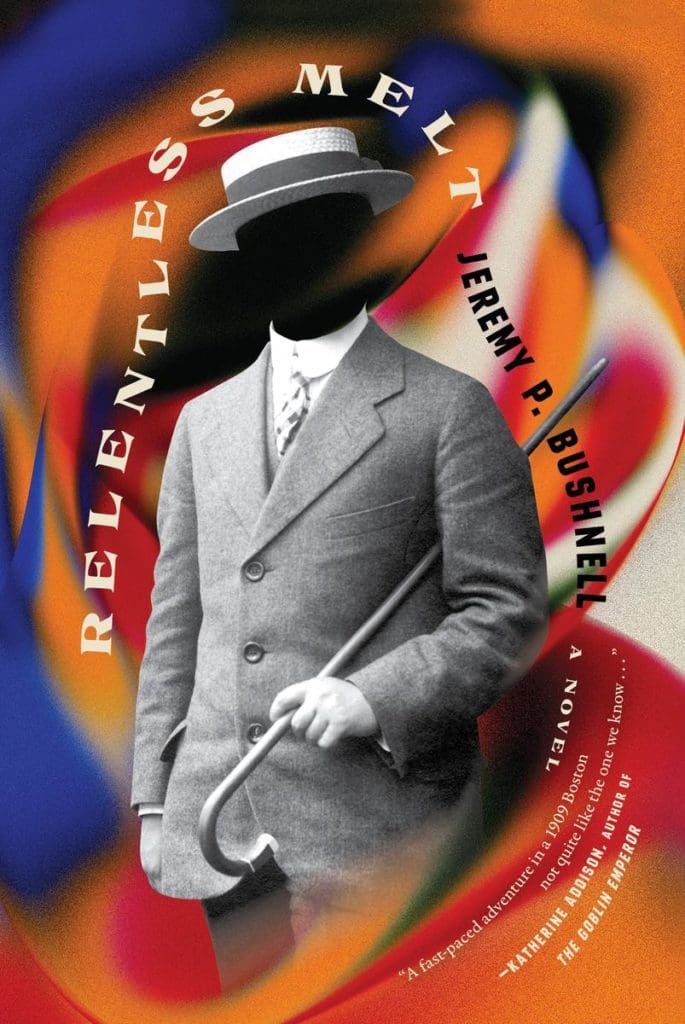Jeremy Bushnell’s been busy on his booktour for Relentless Melt. He appeared for The Poisoned Pen, and you can watch the event here if you missed it. https://www.youtube.com/watch?v=DY_NMZTqG6Y You can order Relentless Melt through the Webstore. https://tinyurl.com/2p8k6tt
Bushnell did a fun article for Crimereads.com, “Soundtracks to Accompany Four Classic Supernatural Novels”. That’s available here. https://crimereads.com/soundtracks-to-accompany-four-classic-supernatural-novels/
And, just this week, Bookreporter.com ran Michael Barson’s interview with Bushnell. Enjoy the interview.
Interview: June 15, 2023
“Stranger Things” meets the Golden Age of Detective Fiction in RELENTLESS MELT, a rollicking supernatural detective thriller by Jeremy P. Bushnell that introduces readers to Artie Quick, a sales assistant at Filene’s in Boston who moonlights as an amateur detective. In this interview conducted by Michael Barson, Senior Publicity Executive at Melville House, Bushnell talks about the extensive research he did for the book, which is his first work of historical fiction; the cross-dressing tendencies of his female protagonist; the books he read as a child that informed the writing of RELENTLESS MELT; and his all-time favorite supernatural novel.
Question: RELENTLESS MELT is your third novel. How did your approach in writing it differ from the way(s) you wrote your first two books?
Jeremy P. Bushnell: I think the biggest difference is that my first two novels were set in the present, and RELENTLESS MELT is set in 1909. That really changes the work that you’re doing, because the need to research becomes a much larger part of the process. I’d done some research for my previous books — especially THE INSIDES, which deals with butchering in a high-end restaurant kitchen — but this was the first one where I needed to do research continuously as I worked on the draft. I was still researching and turning up historical material to include even as I was making my final revisions.
Q: As a writing instructor at Northeastern University, you might have an advantage over many other writers in terms of library discipline. What was your method for organizing the process of that historical research?
JPB: Initially, I really wanted to take a long time to immerse myself in historical material before beginning this novel. I was intimidated by the learning curve of writing historical fiction, and I had this idea that I should have a fully functioning model of 1909 Boston running like a model train set in my head before even starting a draft. But in reality it didn’t play out that way, and in the end I’m not convinced that it would have made much sense to organize the research all out in advance. You can’t always predict what you’ll even need to know until you’re actually writing scenes. I often had to approach the process just by virtue of what I needed to know on any particular day I spent in front of the computer.
Q: Can you give an example of a research need that came up during the drafting process? The kind of challenge you might face on “any particular day”?
JPB: Let’s say you’re writing a scene with a simple “supernatural mystery”-type image — a police investigator peering into the dark. So you imagine it: you picture that investigator shining a flashlight around. But before you can commit that to the page, you suddenly realize you need to do research on the invention of the flashlight, whether they even existed in 1909, whether they were commercially available, whether they were the kind of thing people on a police force might have access to. Those aren’t things I would have necessarily thought I would have needed to research before setting out.
Q: Your protagonist is a teenage girl who seems uncertain as to whether or not she wants to remain a girl. That kind of gender-bending is not something one finds very often in supernatural crime fiction!
JPB: That was something else that emerged from the research, actually. The novel deals a lot with the phenomenon of historical cross-dressing: Artie Quick, the protagonist, spends much of the novel dressed in men’s clothes. We’re all familiar, at least in an abstract way, with historical instances where people lived lives as a gender different from the one they were assigned at birth. There’s been a tendency, traditionally, to interpret these instances as being a form of “disguise” — a woman “pretends to be a man” so that she can get a job, or something like that.
But contemporary historians are looking more carefully into these cases, and it turns out that many of those historical instances were people who nowadays we would consider to be trans-identified: that they were dressing and living that way primarily to affirm their gender identity, not as an elaborate ruse or a game of “pretend.” I didn’t want to write a historical cross-dressing novel without engaging thoughtfully with the reality of what it would be like to be a gender-nonconforming person in that time.
Q: What kind of childhood reading informed the creation of RELENTLESS MELT? Did you read a lot of horror fiction in your youth, or did that element of the book come to you later?
JPB: I had the Dungeons & Dragons core books when I was very young. They’re not exactly horror, but they’re loaded with mysterious environments and fantastic monsters, and the Deities & Demigods supplement book with the H. P. Lovecraft Old Ones in it was my introduction to cosmic horror. A little later, I found Stephen King and devoured all of his books. I am pretty sure that in junior high I read every single book the man wrote between CARRIE (1973) and THE TOMMYKNOCKERS (1987), including the first five Richard Bachman books. Readers might notice some elements of IT popping up in the late pages of RELENTLESS MELT.
Q: Do you have an all-time favorite supernatural novel?
JPB: BELOVED. Unimprovable. It’s not only the greatest supernatural novel of all time, but one of the top five American novels ever written, full stop.


